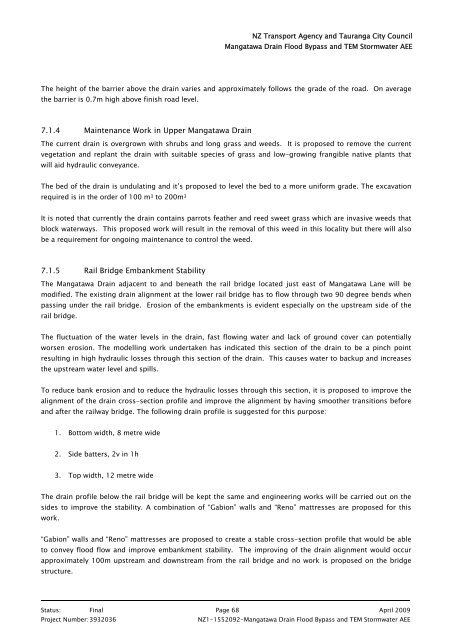2. Mangatawa catchment consents for earthworks, storm water ...
2. Mangatawa catchment consents for earthworks, storm water ...
2. Mangatawa catchment consents for earthworks, storm water ...
- No tags were found...
You also want an ePaper? Increase the reach of your titles
YUMPU automatically turns print PDFs into web optimized ePapers that Google loves.
NZ Transport Agency and Tauranga City Council<br />
<strong>Mangatawa</strong> Drain Flood Bypass and TEM Storm<strong>water</strong> AEE<br />
The height of the barrier above the drain varies and approximately follows the grade of the road. On average<br />
the barrier is 0.7m high above finish road level.<br />
7.1.4 Maintenance Work in Upper <strong>Mangatawa</strong> Drain<br />
The current drain is overgrown with shrubs and long grass and weeds. It is proposed to remove the current<br />
vegetation and replant the drain with suitable species of grass and low-growing frangible native plants that<br />
will aid hydraulic conveyance.<br />
The bed of the drain is undulating and it’s proposed to level the bed to a more uni<strong>for</strong>m grade. The excavation<br />
required is in the order of 100 m 3 to 200m 3<br />
It is noted that currently the drain contains parrots feather and reed sweet grass which are invasive weeds that<br />
block <strong>water</strong>ways. This proposed work will result in the removal of this weed in this locality but there will also<br />
be a requirement <strong>for</strong> ongoing maintenance to control the weed.<br />
7.1.5 Rail Bridge Embankment Stability<br />
The <strong>Mangatawa</strong> Drain adjacent to and beneath the rail bridge located just east of <strong>Mangatawa</strong> Lane will be<br />
modified. The existing drain alignment at the lower rail bridge has to flow through two 90 degree bends when<br />
passing under the rail bridge. Erosion of the embankments is evident especially on the upstream side of the<br />
rail bridge.<br />
The fluctuation of the <strong>water</strong> levels in the drain, fast flowing <strong>water</strong> and lack of ground cover can potentially<br />
worsen erosion. The modelling work undertaken has indicated this section of the drain to be a pinch point<br />
resulting in high hydraulic losses through this section of the drain. This causes <strong>water</strong> to backup and increases<br />
the upstream <strong>water</strong> level and spills.<br />
To reduce bank erosion and to reduce the hydraulic losses through this section, it is proposed to improve the<br />
alignment of the drain cross-section profile and improve the alignment by having smoother transitions be<strong>for</strong>e<br />
and after the railway bridge. The following drain profile is suggested <strong>for</strong> this purpose:<br />
1. Bottom width, 8 metre wide<br />
<strong>2.</strong> Side batters, 2v in 1h<br />
3. Top width, 12 metre wide<br />
The drain profile below the rail bridge will be kept the same and engineering works will be carried out on the<br />
sides to improve the stability. A combination of “Gabion” walls and “Reno” mattresses are proposed <strong>for</strong> this<br />
work.<br />
“Gabion” walls and “Reno” mattresses are proposed to create a stable cross-section profile that would be able<br />
to convey flood flow and improve embankment stability. The improving of the drain alignment would occur<br />
approximately 100m upstream and downstream from the rail bridge and no work is proposed on the bridge<br />
structure.<br />
Status: Final Page 68 April 2009<br />
Project Number: 3932036<br />
NZ1-1552092-<strong>Mangatawa</strong> Drain Flood Bypass and TEM Storm<strong>water</strong> AEE
















